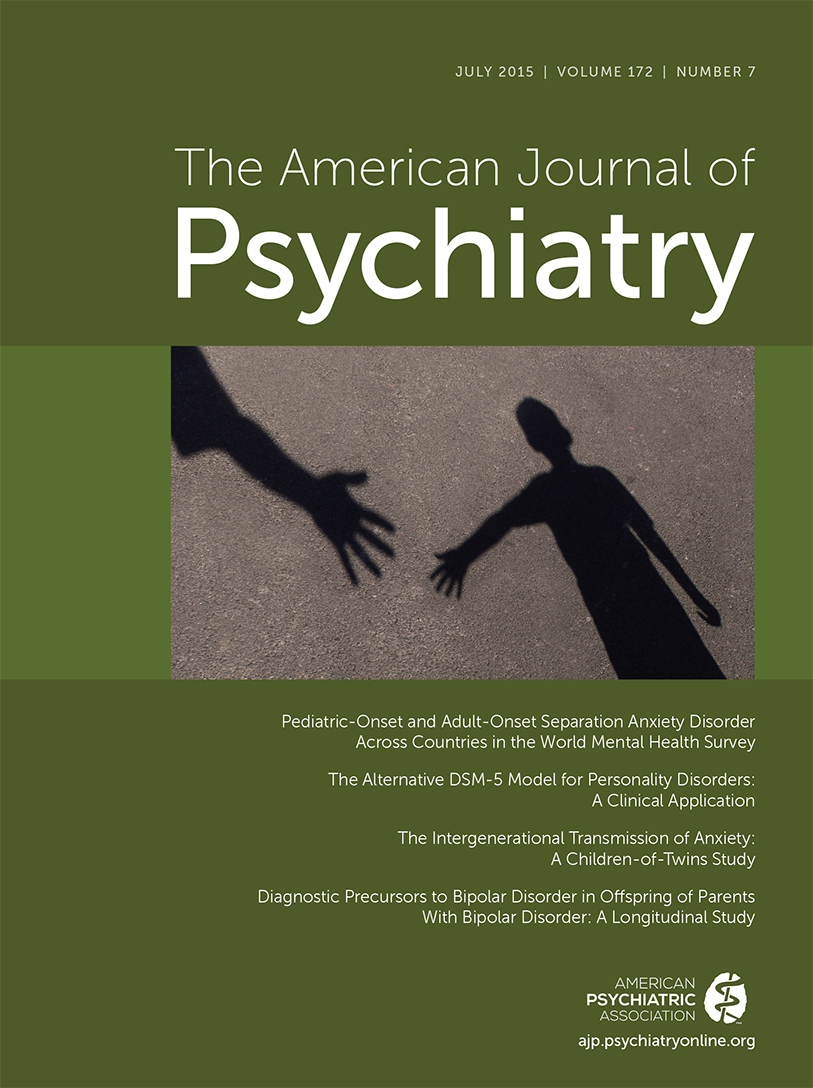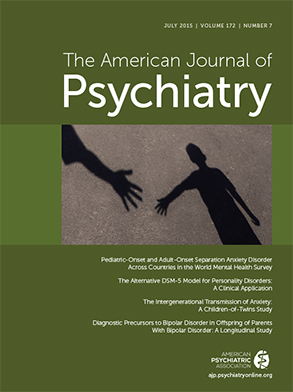Bipolar illness has long been thought to begin in childhood or adolescence, with the oft-cited statistic of an 8–10 year lag between first symptoms in childhood and first treatment by a mental health professional (
1). In this issue of the
Journal, Axelson et al. (
2) present a large-scale longitudinal study designed to identify phenotypic precursors of bipolar illness. In the Pittsburgh Bipolar Offspring Study (BIOS), children of bipolar parents (high-risk group, N=391) and matched children of community parents (comparison group, N=248) were diagnostically evaluated (at mean age of 11.9 years) and then followed for an average of nearly 7 years. Bipolar I or bipolar II disorder developed in 8.4% of the high-risk group and 0.8% of the comparison group. As found in other longitudinal studies and meta-analyses (
3,
4), children of bipolar parents were at higher risk than comparison children for a broad range of internalizing and externalizing disorders, including attention deficit hyperactivity disorder (ADHD) (30.7% compared with 18.2%), anxiety disorders (39.9% compared with 21.8%), and substance use disorders (20.0% compared with 10.1%). These disorders, when comorbid with bipolar disorder, independently contribute to the child’s level of disability. For example, a study of 2,000 adolescents in Taiwan found that the combination of bipolar disorder and ADHD was associated with a threefold higher rate of attempted suicide than bipolar disorder without ADHD (3.0% compared with 1.1%) (
5).
Significantly, the age at onset of the first manic or hypomanic episode in BIOS was much younger than in earlier studies of high-risk offspring (a mean of 13.4 years compared with 17–19 years). In fact, half of the high-risk offspring in BIOS had full manic or hypomanic episodes before age 12. Three diagnoses predicted the onset of mania or hypomania at follow-up: subthreshold manic or hypomanic episodes, major depressive episodes, and disruptive behavior disorders (e.g., oppositional defiant disorder). Only subthreshold manic or hypomanic episodes predicted syndromal manic onset when analyses were based solely on prospective data.
Having a bipolar parent is likely to have effects on the psychological development of children independently of (or in interaction with) genetic contributions, although BIOS was not designed to disentangle these contributions. For example, the children of bipolar parents in BIOS were less likely than the comparison children to live with both biological parents (41.7% compared with 62.1%). Living with only one biological parent has been associated with a longer time to recovery in children and adolescents with mania (
6). In a 16-year longitudinal study, longer duration of exposure to a parent’s bipolar disorder interacted with levels of emotionality in offspring to predict the onset of mood disorder at follow-up (
7). The occurrence of subthreshold manic episodes during critical periods of development (notably, pubescence) or concurrent with life stressors (e.g., parental separation or divorce, increases in family adversity) may increase the overall liability to illness onset among offspring of bipolar parents.
The article by Roberson-Nay et al. (
8) in this issue illustrates the complexity of separating genetic influences from shared and nonshared environmental factors in a broader spectrum of children—those with severe irritability. The authors show that these influences differ considerably between the sexes and at different developmental stages. For example, the genetic contributions to irritability are strongest in girls in middle childhood and decrease over time. In contrast, Eley et al. (
9), also in this issue, report that anxiety and neuroticism in children are best explained by direct environmental transmission from parents.
When the developmental pathways to the onset of bipolar disorder are better understood, we may conclude that certain high-risk offspring are more likely than others to benefit from early interventions focused on environmental stressors. For example, in our group’s trial of family-focused therapy for children of bipolar parents who presented with depression or subthreshold manic or hypomanic episodes (
10), the presence of one or more “high-expressed-emotion” parents (that is, parents who expressed high levels of criticism or emotional overinvolvement toward the offspring) was associated with a stronger response of the child to family-focused therapy than the presence of only “low-expressed-emotion” parents.
Axelson et al. (
2) suggest that clinicians should encourage their adult bipolar patients to have their offspring evaluated by a pediatric mental health professional if they have reason to believe that the child is showing signs of mania, depression, or disruptive behavior disorders. Although this is a reasonable recommendation, there are several impediments that should be acknowledged. First, there are considerable differences in the ways that subthreshold mania or hypomania are defined across nations, cultures, and health care systems, even though the cross-national prevalence of early-onset bipolar disorder (1.8% of people under age 18) is similar in clinical or epidemiological studies (
11). Thus, symptomatic offspring may be more likely to receive treatment in settings that recognize the prognostic value of early-onset subthreshold presentations.
Second, even if we are in a position to offer early diagnosis and treatment, will parents or high-risk children want it? Many bipolar parents do not want their child to know about the parent’s prior experiences with the illness. They fear that talking about it will alienate the child or, worse yet, cause the child to develop bipolar symptoms through imitation. The child may reject the idea that he or she needs treatment for mood-driven behavior that, in the young person’s mind, is no different from that of siblings or other children. However, an early psychosocial intervention may be more appealing to children and families than pharmacotherapy, given the paucity of medication studies in high-risk children and the common risks and side effect burdens associated with psychiatric medications in pediatric populations.
In our experience, presenting early interventions to families is aided by focusing on the disorders that are currently present, rather than those that might develop in the future. A parent may be more receptive to the idea of pharmacotherapy to stabilize the child’s ADHD symptoms and improve school performance than pharmacotherapy to prevent a hypothetical future episode of mania. Indeed, the majority of the children in BIOS who had one or more risk factors did not develop bipolar disorder within the study’s time frame. One can understand a parent’s reluctance to engage their child in treatments to prevent illnesses that are statistically unlikely to occur.
Presenting early intervention options to parents and offspring should emphasize the idea that family relationships can protect against the impact of genetic vulnerability. Traditional family intervention methods, such as communication skills training, problem solving, and behavioral parenting strategies, may enhance resiliency in the family and reduce the likelihood of illness conversion. Therapeutic approaches such as family psychoeducation in which parents and youth are instructed on identifying early signs of mood episodes and taking proactive steps toward stress and symptom reduction may increase the parent’s and child’s self-efficacy in relation to illness management. Parents can be counseled to maximize environmental stability and supports, including encouraging sleep/wake regularity, avoiding high-expressed-emotion parent-child interactions, keeping records of the child’s mood fluctuations in relation to medication changes or stressors, and negotiating with the school system to create educational plans that acknowledge the child’s cyclic mood states and cognitive impairments. Whether these early intervention approaches lead to reductions in the onset of bipolar disorder or reduce the impairment associated with the illness are questions currently under investigation.

